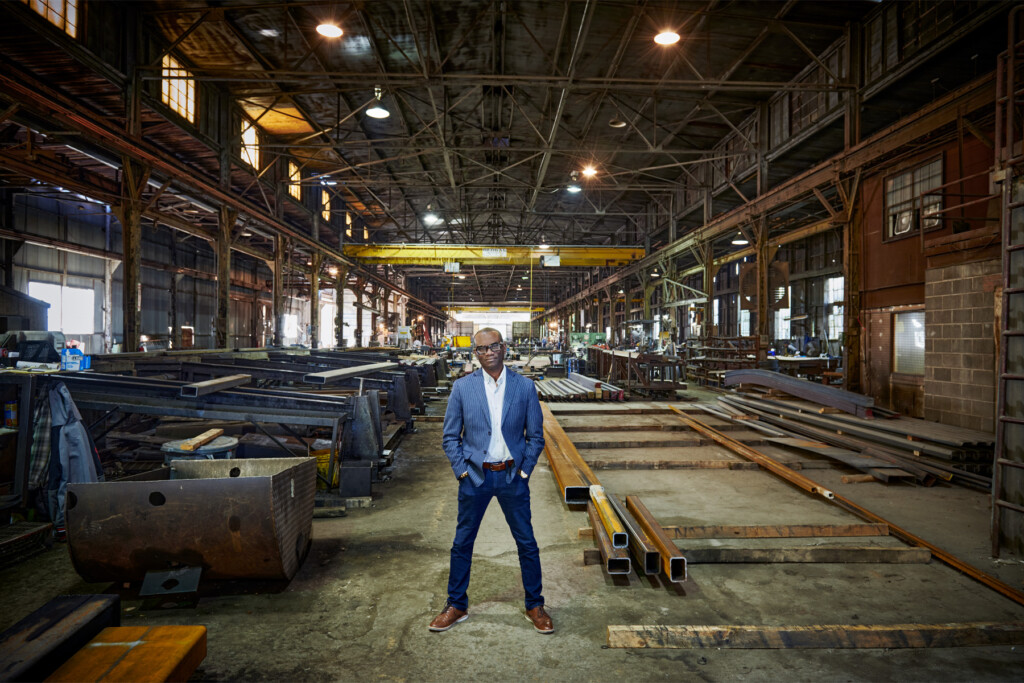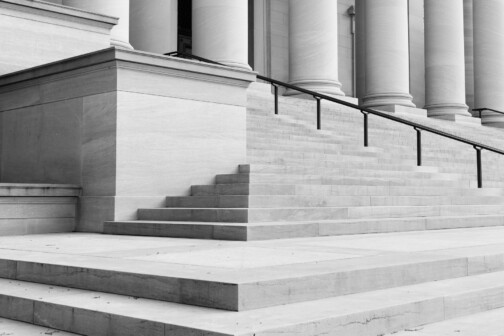Chase Leavell cuts an unusual figure for the co-owner of a steel fabricator in West Dallas. I hasten to admit I have met only one co-owner of a steel fabricator in West Dallas or anywhere else, for that matter. With his easy demeanor, chest-length beard, and long, gray hair held back by a pair of black-framed eyeglasses perched atop his head, he gives off a Dude vibe from The Big Lebowski. Picture the friendliest, most laid-back sea captain you can imagine. That’s Chase Leavell.
Sitting in his laminate-paneled office at Contractors Iron and Steel, where rolls of engineering drawings proliferate, the 47-year-old offers me the short version of his family’s history. His great-great-grandfather came to Dallas in 1898, founded Wyatt Industries, and sold enough boilers that he could afford a house on Swiss Avenue. Leavell’s grandfather, father, and uncle all lived in Lakewood and graduated from Woodrow Wilson High School. His father eventually moved the family to Lake Highlands. Leavell attended Lake Highlands High; his three children now roam its halls.
Leavell wears a Rolex Submariner that his father gave him when he graduated from UNT. By then, he’d already spent a lot of time at Contractors Iron and Steel, which his grandfather had founded and moved in 1963 to its location on North Beckley Avenue. From the parking lot looking roughly east, the view goes: grassy, horizon-gobbling Trinity River levee; squat, brown Dallas County Jail; 72 stories of blue glass on the Bank of America Plaza. In the right light, the glass mirrors the sky, and it seems impossible that so much downtown could be so near such an industrial neighborhood. Leavell started coming here when he was 14. He would sweep up around the shop. He loved the place, how huge the machinery, how huge everything, seemed.
“I’ve always known I wanted to be in this deal,” Leavell says, leaning back in his desk chair, three computer monitors arrayed behind him like a Bloomberg Terminal. “I got a brother, he’s in development. He didn’t want any part of it. My sister, she married a Methodist minister. And, you know, it’s lucky me.” He says this with what, to me, sounds like sardonic humor. But he also means it.
One man’s fun is another’s broken fingers. Leavell learned the business. They buy the steel; “put labor on it,” as he says; and hire erectors to install it for general contractors. He worked his way up from grinder to “hotshot,” driving the finished product to job sites. Their steel went into the 2015 renovation of downtown’s Old Red Courthouse. With his 34 full-time employees, he says there are five or six fabricators in North Texas that can do what his company does.
I enjoyed talking with Leavell. For that pleasure, I owe thanks to a man named Tony Moore—and I suppose, too, Harold Simmons, the billionaire whose widow, Annette, committed $50 million to the creation of a park bearing her late husband’s name. Simmons made the money by means varied and, in some cases, brow furrowing. (Hazardous waste disposal is never an easy business, to say nothing of the management of tax-exempt trusts.) Moore, as president and CEO of the nonprofit Trinity Park Conservancy, which is building the park, bought the land on which Contractors Iron and Steel does its work. After I reported that fact on D Magazine’s blog in September, to Moore’s chagrin, he was still kind enough to put me in touch with Leavell.
Here is where I should tell you that I know things about the park I cannot tell you. I’ll get to that in due course.
This story is a complicated one that goes back to 1998. That’s when Dallas voters approved a $246 million bond program that included some bizarre projects to be built between the Trinity River levees. There was to be a toll road. There was to be a park with lakes whose waters would by plied by solar-powered taxis. Jump to 2018, after the City Council had killed the toll road and after Annette Simmons had donated the $50 million. We would still build a 200-acre park between the levees, and, to prove it, Michael Van Valkenburgh Associates, working for the Conservancy, produced a rendering of a verdant wonderland in the floodway.
Until recently, that seemed to be the plan. But then I came across a months-old report from Channel 5’s Ken Kalthoff in which he broke the news that no actual park construction would take place along the river. I talked to several people who closely follow civic issues; somehow they’d all missed it. Kalthoff stood at the Trinity Overlook Park, which sits on the levee, about two blocks from Contractors Iron and Steel, and said, vaguely, “Instead of down there, between the levees, the planners are now working on a big gateway feature up here at Commerce Street.”
In September, seeing this report, I pulled up the Dallas Central Appraisal District’s website and started clicking, working my way west from Ken Kalthoff. A picture emerged of 70 parcels spread over about 17 acres. Fifty-five of the parcels had changed hands recently and were controlled by the Conservancy. I drew a blue outline on a satellite image of the area and emailed it to Moore. As politely as I could, I asked: is this your park?
Moore asked me not to reveal the blue outline, but sent an official response. In full, it read: “I am truly excited about the expansion of Harold Simmons Park and can’t wait to share the full details soon.”
One man’s “soon” is another’s “too late.” I published the blue outline and wrote that it seemed the park, once planned for 200 acres along a river, was being reduced by about 90 percent and moved to land currently occupied by stuff that did not look like a river.
Then I went to West Dallas and interrupted people who were trying to get real work done. I met Ivan Benitez, a Honduran immigrant who co-owns IBM Upholstery. He builds custom furniture and showed me a chest of drawers he was making for a local billionaire. I met Mercedes Gutierrez, a Nicaraguan immigrant who owns the Speedway Body Shop. Joking about how long her shop has done business at the corner of Beckley and Commerce (since 1985), she pointed east and said, “They built that bridge for me!” Pick your Margaret. The joke works for either of the two Calatrava bridges.
I wanted to explore what lies within the blue outline, which is nearly all industrial and empty lots. Mostly, though, I was hoping to learn when these businesses will have to move. Neither Gutierrez nor Benitez seemed to know. But when I told Moore I’d been talking to his tenants, he invited me to come see something at the Conservancy’s office.
This is when I learned things—saw things—I can’t tell you about. Moore and I agreed that part of our meeting would be off the record, but when we transitioned to on the record, we toggled so many times between on and off that I got confused. Can I tell you that I saw a detailed 3D model? I probably shouldn’t. Here’s what I can tell you:
Moore said that in 2019, a year after those Van Valkenburgh drawings were unveiled, the U.S. Army Corps of Engineers told the Conservancy to stop. Maybe the word is “pause.” But a pause without a foreseeable end feels like a stop. The Corps does flood risk management. It needed soil from the floodway, and it couldn’t predict what would remain for the Conservancy to work with. Moore didn’t join the Conservancy until 2021. This is the first time someone from his organization has publicly acknowledged the stop order. Firm pause request?
Moore said the Conservancy’s plans for the floodway now hew closer to what the late landscape architect Kevin Sloan argued for. “It’s going to be a nature belt,” Moore said. “Access is a must. You cannot have two linear paths [as there are now] without the ability to go east and west.” For this reason and for reasons I can’t tell you about, I must admit I was wrong when I wrote that the park is shrinking. If things go as the Conservancy plans—if—then the park is expanding from the original 200 acres to 250.
Moore said that when he and his team looked for a path that would get the Conservancy out of the Corps’ way, they saw all that land in West Dallas. The biggest swath, 33 contiguous parcels, belonged to Contractors Iron and Steel. That’s when Moore said I should meet Chase Leavell.
The heart of Contractors Iron and Steel is a 1,000-foot-long, two-story-tall metal shed that was built in stages, the first one, Leavell guesses, in the 1920s. Its giant, riveted I-beam columns are a relic from an era when things were built to last. “They’re really cool, as far as steel goes,” he says. Leavell’s father and uncle sold the land to the Conservancy, but Leavell owns the business, and the shed’s steel is the sort of thing a businessman might take with him if he were moving his business to Ennis, which Leavell is. What would a park need with an enormous industrial shed?
I know the right question to ask, and I suspect he knows I’m going to ask it: “Are you taking the shed, Chase?”
He confirms he’s not taking the shed, that he has been told the Conservancy intends to turn it into the park’s signature element. But as we talk more about it, I am stunned to learn that he has never visited the Conservancy’s office and seen certain off-the-record things. He calls the organization “tight-lipped.” I agree and produce my phone, showing him a picture I took of the 3D model.
“That’s us?” he says, smiling with his eyes. “That is so cool.”
By June, Contractors Iron and Steel plans to be out of the West Dallas space it has occupied for 60 years. Chase clarifies that the deadline is of his making, not the Conservancy’s. “I’m excited about the future,” he says. “This area gets to grow, and it gives us a chance to as well. So it’s all good things.”
This story originally appeared in the December issue of D Magazine with the headline “Harold Simmons Park 2.0.” It misidentified Ken Kalthoff as working for Channel 11, which was corrected online. Write to [email protected].
Author








